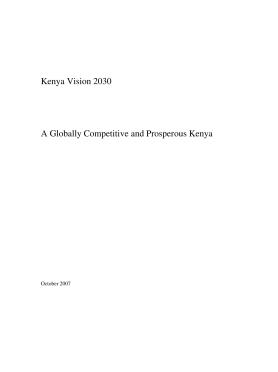Kenya Vision 2030
Kenya Vision 2030
Under the guidance of the Economic Recovery Strategy for Wealth and Employment Creation (ERS), the Kenyan economy has recovered and resumed the path to rapid growth. The economy is expected to grow by more than 6 per cent in 2007 from 0.6 per cent in 2002. The growth has been widely distributed, covering all economic and social sectors resulting in reduction in poverty levels from 56 per cent in 2002 to 46 per cent in 2006. Also this growth has not only impacted positively on the indicators of other MDGs, for example, education, health, gender, and environment, but also availed more resources to address the MDGs across the economy. Currently, more resources have been devolved to the local level through such schemes as the Constituency Development Fund, the Local Authority Transfer Fund, the Constituency Bursary Fund, and the Constituency Aids Fund among others to directly address the MDGs at this level. Despite the development registered under the ERS, the country continues to face challenges in infrastructure and in institutional reforms the need for for highest efficiency in production at firm and household levels. On the whole, Kenyans have reason to be satisfied by the results even though much remains to be done. ERS expires in December 2007 and Kenya will embark on a new long-term vision to guide her development in the next 25 years.
Kenya Vision 2030 is new long-term development blueprint for the country. It is motivated by collective aspiration for a much better society than the one we have today, by the year 2030. The aim of Kenya Vision 2030 is “the globally competitive and prosperous country with a high quality of life by 2030.” It aims at transforming Kenya into “a newly- industrialising, middle income country providing a high quality of life to all its citizens in a clean and secure environment”. In other words the vision aspires to meet the MDGs for Kenyans. The Vision was consultative and inclusive stakeholders’ process carried out between October 2006 and May 2007. Specifically, the process involved international and local experts, ordinary Kenyans and stakeholders from all parts of the country. Between July and August 2007, the contents of the Vision 2030 were again subjected to open consultations in all districts in Kenya, before the finalization of the document.
The Vision is anchored on three key pillars: Economic; Social; and Political Governance. The economic pillar aims to achieve an economic growth rate of 10 per cent per annum and sustaining the same till 2030 in order to generate more resources to address the MDGs. The vision has identified a number of flagship projects in every sector to be implemented over the vision period to facilitate the desired growth that can support the implementation of the MDGs on a sustainable basis. In addition the vision has flagged out projects addressing the MDGs directly in key sectors such as agriculture, education, health, water and environment. The social pillar seeks to create just, cohesive and equitable social development in a clean and secure environment. The political pillar aims to realise an issue-based, people-centred, result-oriented and accountable democratic system.

